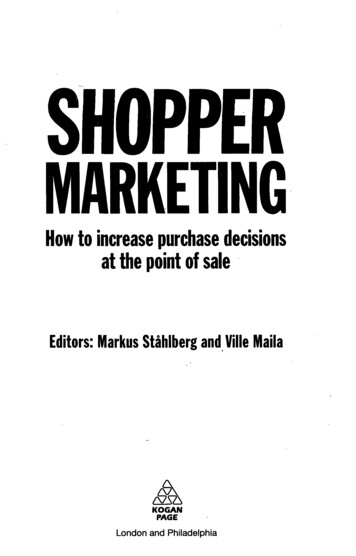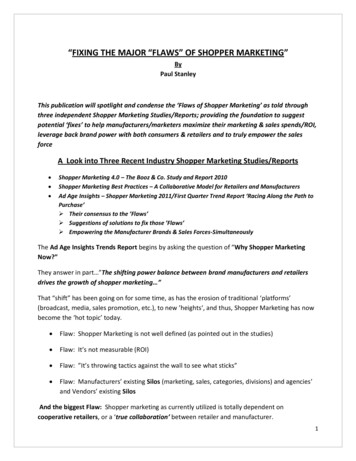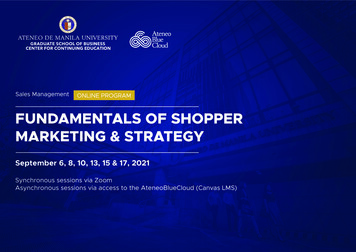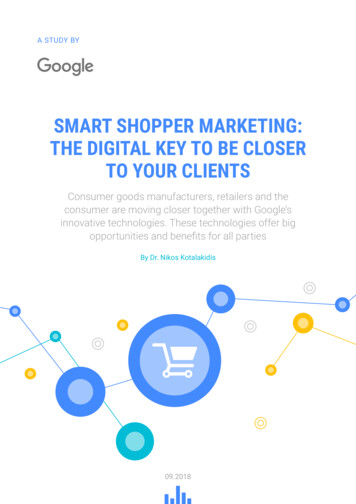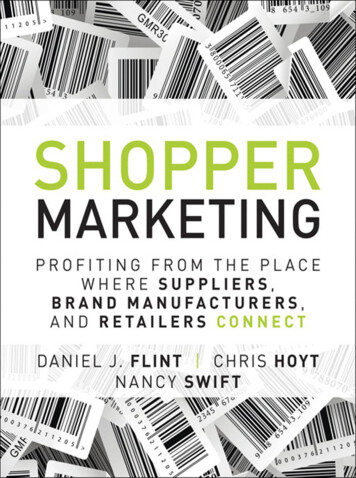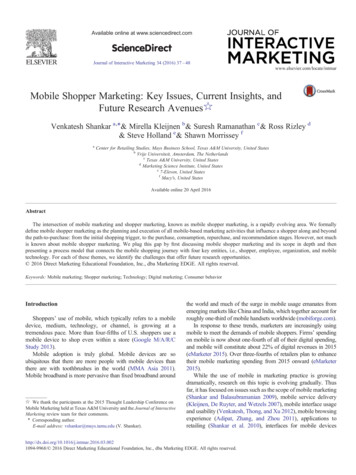
Transcription
Available online at www.sciencedirect.comScienceDirectJournal of Interactive Marketing 34 (2016) 37 – 48www.elsevier.com/locate/intmarMobile Shopper Marketing: Key Issues, Current Insights, andFuture Research Avenues Venkatesh Shankar a,⁎& Mirella Kleijnen b & Suresh Ramanathan c & Ross Rizley d& Steve Holland e & Shawn Morrissey faCenter for Retailing Studies, Mays Business School, Texas A&M University, United StatesbVrije Universiteit, Amsterdam, The NetherlandscTexas A&M University, United StatesdMarketing Science Institute, United Statese7-Eleven, United StatesfMacy's, United StatesAvailable online 20 April 2016AbstractThe intersection of mobile marketing and shopper marketing, known as mobile shopper marketing, is a rapidly evolving area. We formallydefine mobile shopper marketing as the planning and execution of all mobile-based marketing activities that influence a shopper along and beyondthe path-to-purchase: from the initial shopping trigger, to the purchase, consumption, repurchase, and recommendation stages. However, not muchis known about mobile shopper marketing. We plug this gap by first discussing mobile shopper marketing and its scope in depth and thenpresenting a process model that connects the mobile shopping journey with four key entities, i.e., shopper, employee, organization, and mobiletechnology. For each of these themes, we identify the challenges that offer future research opportunities. 2016 Direct Marketing Educational Foundation, Inc., dba Marketing EDGE. All rights reserved.Keywords: Mobile marketing; Shopper marketing; Technology; Digital marketing; Consumer behaviorIntroductionShoppers' use of mobile, which typically refers to a mobiledevice, medium, technology, or channel, is growing at atremendous pace. More than four-fifths of U.S. shoppers use amobile device to shop even within a store (Google M/A/R/CStudy 2013).Mobile adoption is truly global. Mobile devices are soubiquitous that there are more people with mobile devices thanthere are with toothbrushes in the world (MMA Asia 2011).Mobile broadband is more pervasive than fixed broadband around We thank the participants at the 2015 Thought Leadership Conference onMobile Marketing held at Texas A&M University and the Journal of InteractiveMarketing review team for their comments.⁎ Corresponding author.E-mail address: vshankar@mays.tamu.edu (V. Shankar).the world and much of the surge in mobile usage emanates fromemerging markets like China and India, which together account forroughly one-third of mobile handsets worldwide (mobiforge.com).In response to these trends, marketers are increasingly usingmobile to meet the demands of mobile shoppers. Firms' spendingon mobile is now about one-fourth of all of their digital spending,and mobile will constitute about 22% of digital revenues in 2015(eMarketer 2015). Over three-fourths of retailers plan to enhancetheir mobile marketing spending from 2015 onward (eMarketer2015).While the use of mobile in marketing practice is growingdramatically, research on this topic is evolving gradually. Thusfar, it has focused on issues such as the scope of mobile marketing(Shankar and Balasubramanian 2009), mobile service delivery(Kleijnen, De Ruyter, and Wetzels 2007), mobile interface usageand usability (Venkatesh, Thong, and Xu 2012), mobile browsingexperience (Adipat, Zhang, and Zhou 2011), applications toretailing (Shankar et al. 2010), interfaces for mobile 0021094-9968/ 2016 Direct Marketing Educational Foundation, Inc., dba Marketing EDGE. All rights reserved.
38V. Shankar et al. / Journal of Interactive Marketing 34 (2016) 37–48(Brasel and Gips 2014), mobile app demand (Garg and Telang2013), mobile shopping carts (Van Ittersum et al. 2013), mobileadvertising and promotions (Andrews et al. 2015; Bart, Stephen,and Sarvary 2014; Fong, Fang, and Luo 2015), and mobileshopping (Wang, Malthouse, and Krishnamurthi 2015).At the same time, shopper marketing is growing by leapsand bounds (Shankar 2011, 2014). Shopper marketing describes the planning and execution of all marketing activitiesthat influence a shopper along and beyond the path-to-purchase(Shankar 2011, 2014). A shopper differs from a consumer inthat an individual could purchase for consumption by others(e.g., an adult buying for kids) and that a shopper typically is ina shopping mode rather than consuming mode as is the casewith a consumer. Specifically, a shopper is in a setting thatfacilitates purchase decisions, or is in a mindset to shop foritems or products, whereas a consumer could be in anyenvironment facilitating not just purchase but also consumptionor disposal.Research on shopper marketing, however, is sparse, andexisting consumer research does not fully address the gamut ofstages a shopper goes through in the shopping cycle. Shoppermarketing focuses on all stages, including outside store activitiessuch as interactions with the brand, store, and/or other shoppersbefore and after store visit, in both the offline and online context(Shankar et al. 2011).The intersection of mobile marketing and shopper marketing, known as mobile shopper marketing, is a rapidly evolvingarea. Despite shoppers' prolific use of mobile and marketers'shift of resources toward mobile marketing, not much is knownabout the integration of mobile into the shopper funnel. Weformally define mobile shopper marketing as the planning andexecution of mobile-based marketing activities that influence ashopper along and beyond the path-to-purchase: froma shopping trigger, to purchase, consumption, repurchase,and recommendation stages. To provide deeper insights intomobile shopper marketing, we discuss critical issues in mobileshopper marketing from the perspectives of four key entities:shopper, employee, organization, and mobile technology.Before doing so, we first elaborate on the scope of mobileshopper marketing.Scope of Mobile Shopper MarketingIn its most general sense, mobile encompasses severalaspects, including device, medium, technology, and channel.Device refers to the equipment such as smartphone, tablet andlaptop. Medium refers to the means of communication such asapp, email, and print. Technology refers to the hardware andsoftware behind communication such as fixed broadband andwireless broadband. Channel refers to the mode of transactionsuch as mobile, desktop, telephone, and physical store.In its broadest form, shopper marketing covers the gamut ofshopper activities from shopping motivation to post-purchase andincludes both in-store and outside store activities. Therefore, wefocus on mobile-based shopping activities in general but donot deal deeply with mobile advertising, mobile promotions,mobile channels, or mobile gaming. For an overview and deeperdiscussion of mobile advertising and mobile promotions, refer toGrewal et al. (2016) and Andrews et al. (2016), respectively.Similarly, for a comprehensive treatment on mobile gaming, seeHofacker et al. (2016).From a device perspective, mobile can be seen as any centrallyconnected portable device that can be used in motion. Such adevice ranges from a cellphone to a tablet. A mobile device helpscustomers perform a number of activities and make decisions onthe move. Most users would feel lost without them. Mobile devicesallow shoppers to use multiple apps, surf the web, and useaudiovisual features such as talking and viewing.From a technology standpoint, mobile enables the delivery ofcontextually relevant information (e.g., location, time, speed oftravel, date events, and weather) to shoppers. From a mediumviewpoint, firms can use mobile to view and hear shoppers'voices and manage customer relationships. In terms of being achannel, mobile offers shoppers' transaction data to firms,enabling them to analyze and predict shoppers' needs andwants. At the highest level, mobile is an integral part of a firm'soverall marketing strategy, and in particular, its SMACIT (Social,Mobile, Analytics, Cloud, and Internet of Things) strategy. In agrowing number of organizations, the SMACIT strategy isgaining prominence because these elements are interrelated andare fast becoming a significant part of organizations' digitaltransformation (Ross 2014).The influence of mobile on shopping extends well beyondin-store use of mobile devices. It affects every stage in theshopping cycle of not just the shopper but also his/her socialcircle. The implications of mobile marketing extend far beyondthe physical store. It involves all the planning and executionsteps of marketing activities. The shopping journey is alsocircular, which means it does not have a starting or ending point(Walker 2011). Rather, it is a cycle that shoppers can join orleave at any point, and mobile marketing can influence any ofthese points in the shopping cycle.One way to analyze the scope of mobile in the shoppingcycle is to split it into three broad stages: before purchase,during purchase, and after purchase. Shoppers, employees, andorganizations (retailers, manufacturers, and service providers)face a number of critical issues relating to mobile shoppermarketing across the different stages in the shopping cycle.Underlying the roles of different stakeholders is also the mobiletechnology itself, as changes in mobile technology directly orindirectly affect the role of mobile in the behavior of shoppers,employees, and organizations. An organizing framework basedon these entities and stages appears in Fig. 1.The remaining sections develop research question in relationto the four themes represented in Fig. 1: the shopper, theemployee, the organization, and mobile technology (see alsoTable 1). Under shopper-related mobile issues, we discussshopper motivation/goals, search, discovery, evaluation, consideration, choice, and post-purchase. Under employee-relatedmobile issues, we cover employee roles, metrics and incentives.Under organization-related mobile issues, we elaborate ondata-related, resource allocation, and spending issues. Finally,under mobile technology related issues, we discuss convergenceand wearables, two important future issues.
V. Shankar et al. / Journal of Interactive Marketing 34 (2016) 37–4839Fig. 1. Mobile shopper journey and research questions.Shopper-related Mobile IssuesShopper Motivation/GoalsTraditional models of shopper marketing assume thatshoppers come into the store with a particular goal in mindand shop according to that goal. Based on the goal, shoppersmay be classified as convenience shoppers, variety-seekers,balanced buyers, and store-oriented shoppers (Rohm andSwaminathan 2004). Shopping goals can be classified asutilitarian or functional (e.g., purchasing products in a timely orefficient manner) versus hedonic or experiential (e.g., shoppingfor the fun or the adventure elements (Babin, Darden, andGriffin 1994; Sherry 1990). Social affiliation could also beanother goal category as use and gratification theory suggests(Lariviere et al. 2013b). For example, a shopper could post aselfie of her with a new apparel and post it for viewing by hersocial circle, enabling her to express her identity. Furthermore,some of these goals are conscious and people may be aware oftheir influence, whereas others may be habitual, automatic, orchronic such that their influence on behavior has receded fromconsciousness (Bargh et al. 2001).Mobile changes the way we view shopping goals because itcan be used to contextually prime other goals while the shopperis shopping, causing a dynamic shift in goal pursuit. Forexample, mobile apps could exploit the conflict betweenshopper deal-proneness and the need for immediate gratification by using triggers to shift focus from wanting a good dealand saving money to paying more to get immediate delivery.Mobile shopping combines two very important ideas, interactivity and instantaneity. Other platforms and media may offerinteractivity, but they do not do so at the moment of truth asmobile does. However, there can be a cost to this instantaneity.In a brick-and-mortar environment, once a shopper enters theimplementation mindset, focusing on how to best executepreviously made shopping plans, there is very little shiftingback to deliberation. Mobile devices make shifting back andforth between deliberation and implementation more feasibleby providing instantaneous information that can lead toabandonment or acceleration of previous shopping plans.Consequently, mobile marketing could likely strengthen orinhibit chronic goals already present, such as deal-proneness(Blattberg and Neslin 1990; Lichtenstein, Netemeyer, andBurton 1995) or reward-seeking (Ramanathan and Menon2006). The ubiquity of contextual mobile coupons and offerswhen shoppers are near a store could lead to deal-proneshoppers becoming even more predisposed to such intervention. Indeed, using a mobile device to place orders onlineincreases the order rate and order size and enhances the futureincidence of ordering habitual products through mobile andlocking them in for subsequent purchases (Wang, Malthouse,and Krishnamurthi 2015).Contextual offers trigger shopper motivation to shopbecause their serendipity and unexpectedness create a positiveaffect (Heilman, Nakamoto, and Rao 2002; Walker Naylor,Raghunathan, and Ramanathan 2006). Such offers have beenshown to lead to larger shopping baskets and to increase thenumber of unplanned purchases (Heilman, Nakamoto, and Rao2002). In particular, offers that are compatible with shopperpredispositions such as prevention or promotion focus may leadto significant increases in basket size (Ramanathan and Dhar2010).Mobile may offer marketers the opportunity to track suchpredispositions dynamically, make relevant offers, and trigger
40V. Shankar et al. / Journal of Interactive Marketing 34 (2016) 37–48Table 1Research avenues and unexplored questions.EntityAreas of interestResearch questionsShopperMotivation/shopping goalsRQ–S1)How do we design mobile apps that tap into goods that are dynamic in relation to the shoppingcycle and context?Search and discoveryRQ–S2)RQ–S3)How do we better measure and enhance mobile shopper engagement?How can marketers optimize their mobile app design to best influence shoppers on their path topurchase?RQ–S4)RQ–S5)RQ–S6)RQ–S7)How should apps be designed to deliver rich experiences across a wide range of devices?How can marketers enhance mobile co–creation?How can mobile enable shoppers to serendipitously discover a potential purchase?How can marketers design a dream concierge/intelligent avatar–knowledge based system/expertsystem–to assist shopping?RQ–S8)In designing intelligent recommendation systems, how can marketers walk the fine line betweencreating personalized solutions but not being perceived as creepy?RQ–S9)RQ–S10)RQ–S11)How can mobile create more relevant/valuable relationships with the individual shopper?How can mobile be used to create context–related and timely value to shoppers?How can the instantaneity of mobile be exploited to create different forms of instant gratificationfor the engaged shopper?Post–purchaseRQ–S12)How can marketers create a positive network effect among shoppers in a social network afterpurchase of one category through links across mobile apps?Employee rolesRQ–E1)RQ–E2)How does mobile change the shopping journey (pre, during, and post) from an employee perspective?What are the factors that create resistance toward mobile technologies from the employeeperspective, and how can firms develop coping strategies to overcome this resistance?RQ–E3)How can employees utilize the mobile device within the shopping journey to created new valuepropositions?RQ–E4)RQ–E5)RQ–E6)How can employees be incentivized to become mobile shopper marketing ambassadors?How can employees be utilized as co–creators of mobile shopping experiences?How should employee–mindset metrics be conceptualized, defined, and measured in the context ofthe mobile shopping journey?RQ–E7)How should employee performance be measured throughout the mobile shopping journey?RA–O1)How can firms effectively develop and maintain their social capital in the context of mobileshopper marketing?RQ–O2)How should mobile execution capability be conceptualized, defined, and measured to enhance themobile shopping experience?RQ–O3)How can firms effectively develop and maintain partnering networks relevant to delivering asuperior mobile shopper experience?RQ–O4)What are the right conversion metrics relating to mobile shopper marketing relative to othermarketing activities?RQ–O5)How can the return on the investment (ROI) or digital yield on mobile shopper marketinginitiatives be quantified compared to that for other desktop related digital activities?RQ–O6)RQ–O7)RQ–O8)How should firms spend their limited marketing budgets?How much money should be allocated to mobile versus other digital marketing activities?How should firms determine the proportion of the marketing budget that should be devoted tomobile shopper marketing?RQ–O9)RQ–O10)How can we harness the dynamic (time, location, weather) nature of mobile data?How can we leverage the volume, velocity, variety, veracity of mobile data and derive value for thefirm?RQ–O11)RQ–O12)RQ–O13)How can we value mobile data?What is the price of collecting the data that mobile shoppers want to share?How can we enhance data security in a mobile networked world where firms share (APIs) withtheir partner organizations?RQ–O14)RQ–O15)How can we formulate effective decision models with mobile data?How can we integrate mobile data with other data, including offline activities and demographicdata and develop cogent models?RQ–O16)RQ–O17)How can we analyze mobile data to formulate models that explain shopper behavior?How can we develop predictive models that can forecast mobile shopper behavior at both theindividual and the aggregate levels?RQ–O18)How should firms use mobile data to assist real time mobile marketing decisions?RQ–T1)As shoppers increasingly search on their mobile devices through Google and as Google becomesmore powerful using shopper data, what technologies can retailers deploy to avoid becoming thefulfillment centers of Google and remain competitive?RQ–T2)How can marketers leverage technology and use data on shoppers' past purchase patterns andvoluntarily disclosed preferences for offering anticipatory solutions?RQ–T3)How can marketers use mobile–based virtual currencies in a manner similar to M–pesa, Coke'sMyCokeRewards, and China's QQ?RQ–T4)How will new mobile payment technologies (e.g., Apple Pay, Google Wallet) and systems affectshopping?RQ–T5)What differences in mobile shopping will emerge across North America, Europe, Asia, and therest of the world given the differences in mobile technologies across these geographies?RQ–T6)How can emotion–capture and analyze technology be used to better serve shopper needs?RQ–T7)RQ–T8)RQ–T9)RQ–T10)How will augmented reality reshape mobile shopping experience?Will augmented reality lead to a fundamentally different shopping cycle?How can we measure shopper emotions through wearables?How can we create compelling shopper experiences based on shopper emotional states?Evaluation, consideration,and choiceEmployeeEmployee metrics andincentivesOrganizationResource allocation andspending issuesData–related issues–collection and managementData–related issues–modeling and analysisMobile technologyConvergenceWearables
V. Shankar et al. / Journal of Interactive Marketing 34 (2016) 37–48purchases. For example, Pizza Hut China is offering shoppersnear the vicinity of its over 1,400 restaurants movie ticketprizes through a WeChat messaging application as a reward forinteracting with beacons inside their restaurants through theirsmartphones. A mobile promotional coupon can increaseunplanned spending by 16.1% and if it requires shoppers totravel farther from their planned path, it could boost unplannedspending more than a mobile coupon for a category near theirplanned path (Hui et al. 2013). Furthermore, trajectory basedmobile communications trigger shopper goals and enhancetheir spending (Ghose, Li, and Liu 2015).While firms receive value from such dynamic tracking ofshoppers, there may be serious concerns about privacy andintrusiveness (Belanger, Hiller, and Smith 2002). Shoppersgenerally dislike mobile ads, with a report showing that fourout of five customers found them unacceptable due to theirintrusiveness (Gupta 2013). While shoppers are typicallyengaged with mobile apps, they use only a few of these appsregularly. Although the average smartphone has about 40 apps,shoppers typically use only about 15 or less regularly (Gupta2013). Only a few of these apps are for brands or stores, so thecompetition for app space on a shopper's mobile device can berather daunting for marketers to overcome. The key for marketersis to get their app on the first screen of the mobile device.Another aspect of mobile is that it provides users with a feelingof constantly being in touch, with both the external environment atlarge and the users' own social connections (Stafford andGillenson 2004). Shoppers do not merely expect mobile shoppingservices to be useful in meeting their functional goals, they expectthe mobile shopping services to serve their enjoyment andself-expression needs (Nysveen, Pedersen, and Thorbjørnsen2005). These needs are often neglected by the marketer.Branded apps can help improve shopper awareness of productsand offers and boost spending. Branded apps and mobile platformsserve as effective and personalized marketing communicationtools (Wang, Kim, and Malthouse 2015). The use of two maininteractive features of a branded app – information lookup andcheck-in – increases app adopters' spending levels, but whenshoppers discontinue using the app, their spending levels decrease(Kim, Wang, and Malthouse 2015). Therefore, apps need to besticky to induce shoppers to continue using them and should becontinuously updated and redesigned to remain the state-of-the-art.In our view, mobile marketing apps with the greatest chance ofsuccess in a crowded device environment are those that balancefunctional needs with hedonic and social affiliation needs. Theubiquity of interactive tools and apps for photos, video andmusic, and social media, creates opportunities for co-creation ofvalue via user-generated communication, product design, andcustom experiences that best meet the variety of shopper needs.Importantly, such needs should be tracked dynamically so thatrelevant content, whether functional/informative or hedonic/entertaining, is delivered appropriately. Furthermore, increasingshopper engagement will entail measuring it on an ongoing basisusing mobile interventions. Mobile shopper engagement refers tothe involvement of the shopper in her shopping experiencethrough mobile. It is higher when mobile shopping experience ismore personal and pleasurable.41These issues lead to some unanswered research questions.How do we design mobile apps that tap into goals that aredynamic in relation the shopping cycle and context (S1)? Howdo we better measure and enhance mobile shopper engagement(S2)? Engaged shoppers are likely to purchase more items, moreoften than non-engaged shoppers. Measuring engagement inresponse to mobile interventions is challenging because of theabsence of a robust system to track shopper behavior following amobile intervention due to privacy concerns, self-selection bias,and difficulty in linking mobile use to purchases in other channels.Search and DiscoveryShoppers use mobile for one or more of the followingactivities: browse the web, use apps, find store location/directions,find store hours, compare prices, access promotional offers, findwhere specific products are sold, find product information, findproduct availability in-store, find product reviews, and make apurchase (Google M/A/R/C Study 2013). Convenience andsavings are the primary motivations for using a mobile phonefor shopping. Mobile shoppers desire clean, easy-to-use sites andapps and perceive self-service as the main value derived frommobile (Ericson, Herring, and Ungerman 2014).Mobile also allows shoppers more opportunities in their searchstrategies. It can serve as an intelligent agent (e.g., Siri, GoogleNow, Cortana), enhancing the customer's entire shoppingexperience. It allows shoppers to search product reviews andexperiences of other shoppers quickly and instantaneously whileon the move. Mobile optimized and search engine friendly retailsites are likely to accelerate search and discovery. For example,searching a store on a mobile device should return store contactdetails with maps and hours of operation, increasing the chancesof shopper's selection of the store (Kim, Wang, and Malthouse2015; Wang, Kim, and Malthouse 2015).While convenience and savings may be the fundamental driversof mobile search, there are other reasons why consumers findmobile search and discovery attractive. Mobile devices provide asense of immediacy, offering a realization of having everythingaccessible literally at one's finger-tips. Marketers who facilitate asense of discovery and serendipity during the pre-purchase processwill likely benefit from increased user engagement.As the number of form factors in mobile devices increases,marketers will face the challenge of designing apps that helpshoppers search and discover appropriate solutions and delivera consistently rich experience in a device-agnostic manner. Asmarketers try to increase their presence on mobile devices viaapps, the risk of choice and information overload increasessignificantly for shoppers. In particular, the constraints ofphysical space combined with the use of mobile apps asextensions of websites may exacerbate the sense of overloadand frustration. It is therefore incumbent on the marketer toview apps not just as extensions of their websites but as tools tocreate and sustain shopper engagement through customized anduser-relevant solutions. Rather than simply transferring tetheredweb content to a mobile app with limited functionality,marketers need to tap into the unique capabilities offeredacross different form factors to provide a seamless and painless
42V. Shankar et al. / Journal of Interactive Marketing 34 (2016) 37–48interactive experience. These capabilities include geo-targeting(based on the user's location) and micro-content (very shortduration content designed for mobile devices).From the app design standpoint, several research questionsremain open. How can marketers optimize their mobile app designto best influence shoppers on their path to purchase (S3)? Aneffective app design involves key decisions on form factor andresponsiveness across devices and browsers. How should appsbe designed to deliver rich experiences across a wide range ofdevices (S4)?The next frontier in mobile marketing lies in enhancingshoppers' ability to co-create products, experiences, and communication. One way such co-creation can occur is through apps thathelp shoppers use the photo and video capabilities of mobiledevices to design customized products. Shoppers can share thecreations from such apps with others and refine the creations withtheir input, allowing social co-creation. Shoppers can use mobiledevices to design their own shopping experience, for example, bychoosing whether they wish to receive offers or deals to savemoney on a given shopping trip driven by savings goals or toreceive offers for hedonic rewards and freebies on a trip driven byhedonic goals. Mobile offers unique opportunities for shoppers togenerate content for communication, and to use the rich mediacapabilities of devices to create blogs or videos for sharing ononline brand communities.Marketers wish to determine how they can design shoppercreated or co-created offerings/experiences. By involving theshopper in the offering or experience, marketers can engage theshopper more and get their buy-in. How can marketers enhancemobile co-creation (S5)? How can mobile enable shoppers toserendipitously discover a potential purchase (S6)? More researchis needed to address these questions.Evaluation, Consideration, and ChoiceA study by McKinsey & Company found that digital touchpoints, including mobile devices, were highly relevant at theshopper decision journey's stages, in particular, the evaluationstage (Banfi et al. 2013). In fact, the study found that digital touchpoints, have replaced traditional touch points (i.e., face-to-faceinteractions) as the primary contact between the marketer and theshopper during some stages of the decision journey.As the shopper navigates online or offline (aisles of a store),evaluates different offers, and considers possible solutions,mobile expert systems and “shopping concierges” can providerich interactive experiences. In-store sensors or beacons linkedto apps on mobile devices may trigger location-specificinterventions within the store, leading to more targeted andcustomized experiences for the customer. For example, Macy'suses iBeacon, a mobile technology platform, to alert in-storeshoppers about deals and customized offers, assess differentofferings, and increase purchases. Shopping avatars or smartagents could suggest accessories and complementary productsbased on stored information about the shopper's inventory andprior tastes. These tips could then be translated into choice bythe use of quick response (QR) codes and other instantaneousinterventions delivered to the device on a location-specific andtargeted basis. Two unresearched relevant questions in thiscontext are as follows: How can marketers design a dreamconcierge/intelligent avatar – knowledge based system/expertsystem – to assist shopping (S7)? In designing such intelligentrecommendation systems, how can marketers walk the fine linebetween creating personalized solutions but not being perceived as creepy (S8)?A potential challenge that marketers may face is that mobiledevices are not very conducive to extensive information searchand processing that requires si
Shopper marketing focuses on all stages, including outside store activities such as interactions with the brand, store, and/or other shoppers before and after store visit, in both the offline and online context (Shankar et al. 2011). The intersection of mobile marketing and shopper market-ing, known as mobile shopper marketing, is a rapidly .
